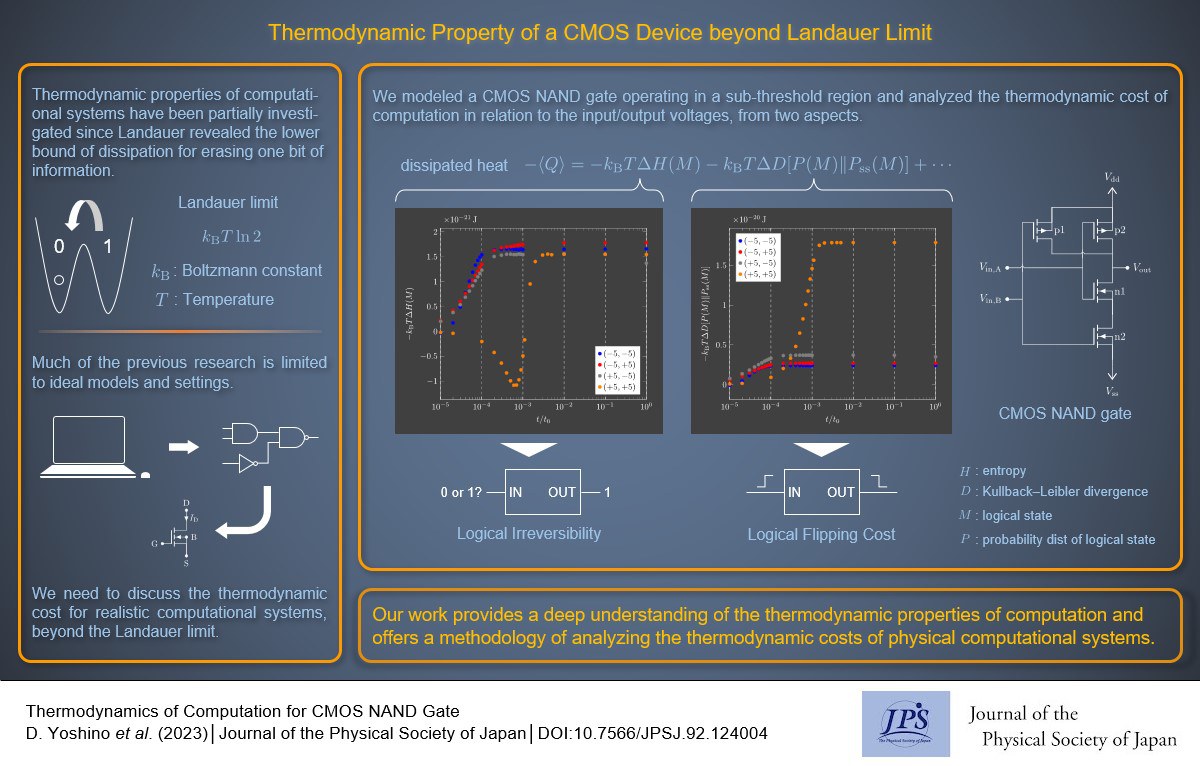Thermodynamic Property of a CMOS Device beyond Landauer Limit
© The Physical Society of Japan
This article is on
J. Phys. Soc. Jpn.
92,
124004
(2023)
.
Focusing on a CMOS NAND GATE operating in a sub-threshold region, the thermodynamic cost of computation was analyzed in relation to input/output voltages surpassing the Landauer limit.

Understanding the thermodynamic properties of computation is not only physically interesting but also holds significant practical implications.
In 1961, Rolf Landauer from IBM introduced the Landauer principle, establishing a lower bound for the dissipation of energy required to reliably erasing one bit of information. The bound is expressed as kBT ln 2, where kB is the Boltzmann constant, and T is the temperature of a thermal reservoir. This value is approximately 3.0✕10-21 J at room temperature. Although extremely small, achieving this limit is feasible through the quasi-static erasure process of memory. However, practical implementation may result in increased energy dissipation. Beyond serving as mere memory systems, computers execute complex mathematical operations through logic circuits composed of numerous logic gates. Hence, discussing the thermodynamic properties of this system is interesting.
Recent advancements in nonequilibrium statistical mechanics have unveiled instances of dissipation surpassing the Landauer bound in practical applications. In addition to memory systems, the thermodynamic analysis of more complex computers, such as logic circuits, Brownian computers, and models proposed in computer science, has become possible. However, existing studies are limited to ideal models and settings. For physically implemented computers, only a few studies have analyzed the relationship between computational processes and their thermodynamic properties.
This study focuses on a specific logic gate and analyzes the thermodynamic properties in terms of the extended Landauer bound. NAND gates, comprising CMOS transistors operating in sub-threshold regions, exhibit additional dissipation due to dynamic changes in the logical states encoded in the output voltage. These findings have been quantitatively revealed.
The Landauer bound stems from logical irreversibility and the inability to accurately infer the input from the output state after computation. This reduces the number of logical states (M) to be realized before and after the computation, thus increasing the corresponding entropy (H), up to ln 2 in the case of a 1-bit complete information erasure. In this study, alongside the dissipation associated with this logical irreversibility, an additional dissipation, contingent on the initial system distribution, was identified through an investigation of the Kullback-Leibler divergence. While no difference was observed in the former dissipation under varying input voltage conditions, the latter exhibited greater dissipation under certain conditions. We interpret this factor as a consequence of logic state flipping.
The relevance of thermodynamic properties for more complex physical computers has not been completely understood, and further research is required.
(Written by D. Yoshino on behalf of all authors)
J. Phys. Soc. Jpn.
92,
124004
(2023)
.
Share this topic
Fields
Related Articles
-
Qualitative Changes in Kinetic Pathways Driven by Hydrodynamic Interactions in Dense Colloidal Suspensions
Cross-disciplinary physics and related areas of science and technology
Statistical physics and thermodynamics
Structure and mechanical and thermal properties in condensed matter
2025-4-18
Even in dense colloidal suspensions, where long-range hydrodynamic interactions are screened, near-field hydrodynamic interactions qualitatively influence the selection of kinetic pathways.
-
Overcoming Phase Transitions for Faster Quantum Annealing
Statistical physics and thermodynamics
2025-3-27
This study presents an innovative method to address the problem of phase transitions in quantum annealing, resulting in an exponential speedup of the process.
-
Exploring the Vibrant Interplay of Machine Learning and Physics
Cross-disciplinary physics and related areas of science and technology
Electron states in condensed matter
Elementary particles, fields, and strings
Mathematical methods, classical and quantum physics, relativity, gravitation, numerical simulation, computational modeling
Statistical physics and thermodynamics
Superconductivity
2025-3-13
This Journal of the Physical Society of Japan Special Topics edition explores how physics and machine learning complement each other and can solve unresolved problems in physics.
-
A Unified Theory of Topological Hall Effect
Electronic transport in condensed matter
2025-3-6
This paper presents a unified theoretical description for the topological Hall effect, covering the entire region from strong- to weak-coupling, extending its picture beyond the Berry phase.
-
Excitonic Insulators: Challenges in Realizing a Theoretically Predicted State of Matter
Electron states in condensed matter
Electronic transport in condensed matter
2025-3-3
The realization of an excitonic insulator can help in the establishment of a new electronic state in condensed matter physics, one that has the potential to exhibit novel electric, magnetic, and optical responses beyond those of conventional materials.




